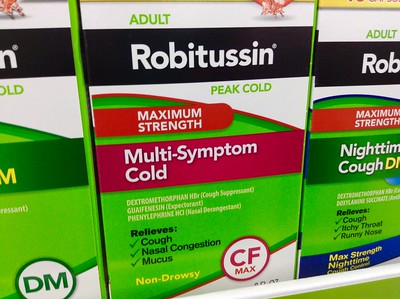Antitussives
Antitussives are frequently used to prevent cold and flu symptoms. In this chapter, we will review one commonly used specific antitussive called Dextromethorphan.
Dextromethorphan is an example of an antitussive (see Figure 5.8[1]).

Mechanism of Action
Dextromethorphan suppresses a cough by depressing the cough center in the medulla oblongata or the cough receptors in the throat, trachea, or lungs, effectively elevating the threshold for coughing.
Indication for Use
Antitussives are used for a dry, hacking, nonproductive cough that interferes with rest and sleep.
Nursing Considerations Across the Lifespan
This medication is not safe for children under the age of 4 years.
Adverse/Side Effects
The most common side effects include nausea and drowsiness. Some clients may experience a rash or difficulty breathing. High doses may cause hallucinations and disassociation, and the drug has been reported to be used as a recreational drug.[2]
Client Teaching & Education
Clients should take care to avoid irritants that stimulate their cough. Additionally, antitussive medications can cause drowsiness, and clients should avoid taking them with other CNS depressants or alcohol.[3]
Dextromethorphan Medication Card
Now let’s take a closer look at the medication card on dextromethorphan.[4], [5], [6]
Medication Card 5.8.1: Dextromethorphan
Class: Antitussives
Prototypes: Dextromethorphan (Robitussin DM)
Mechanism: Suppresses a cough by depressing the cough center in the medulla oblongata or the cough receptors in the throat, trachea, or lungs that effectively elevate the threshold for coughing
Therapeutic Effects
- Prevents coughing or decreases the frequency
Administration
- PO by elixir
- Adults (12 years and over) 2 tsps every 6 hrs
- Not for use in children under 12 years old
Indications
- Antitussives are used for a dry, hacking, non-productive cough that interferes with rest and sleep
- Temporary relief of cough and minor throat and bronchial irritations from common cold or cough
- Itchy watery eyes
Contraindications
- Not safe for children under 12 years of age
- Has been used for recreational drug abuse to induce hallucinations this is a concern due to risk of overdose and impaired breathing
- Do not take with alcohol
- If taking MAOI’s consult doctor for further instruction
- If taking puffers for respiratory diseases such as albuterol review with pharmacist if there are any interactions
Side Effects
- Nausea
- Drowsiness
- Rash
- Adverse effect difficult breathing
SAFETY: Use cautiously with respiratory disease such as bronchitis, asthma or emphysema and people taking MAOI drugs
Nursing Considerations
- High dosage can cause hallucinations and disassociation
- Avoid irritants that stimulate more coughing
- Teaching related to possible multiple drugs in one over the counter medication needs to be addressed for example acetaminophen
- If symptoms persist more than 3-5 days seek medical assessment again
- "Robitussin Cough Cold Flu Congestion decongestant Relief Medicine" by Mike Mozart is licensed under CC BY 2.0 ↵
- Frandsen, G. & Pennington, S. (2018). Abrams’ clinical drug: Rationales for nursing practice (11th ed.). Wolters Kluwer. ↵
- uCentral from Unbound Medicine. https://www.unboundmedicine.com/ucentral ↵
- This work is a derivative of Pharmacology Notes: Nursing Implications for Clinical Practice by Gloria Velarde licensed under CC BY-NC-SA 4.0. ↵
- Frandsen, G. & Pennington, S. (2018). Abrams’ clinical drug: Rationales for nursing practice (11th ed.). Wolters Kluwer. ↵
- This work is a derivative of Daily Med by U.S. National Library of Medicine in the public domain. ↵

